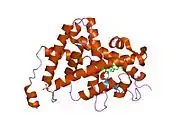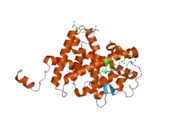Thyroid hormone receptor alpha (TR-alpha) also known as nuclear receptor subfamily 1, group A, member 1 (NR1A1), is a nuclear receptor protein that in humans is encoded by the THRA gene.[5][6][7]
Function
The protein encoded by this gene is a nuclear hormone receptor for triiodothyronine. It is one of the several receptors for thyroid hormone, and has been shown to mediate the biological activities of thyroid hormone. Knockout studies in mice suggest that the different receptors, while having certain extent of redundancy, may mediate different functions of thyroid hormone. Alternatively spliced transcript variants encoding distinct isoforms have been reported.[5]
Role in pathology
Mutations of the THRA gene may cause nongoitrous congenital hypothyroidism-6, a subtype of congenital hypothyroidism.
Interactions
THR1 has been shown to interact with:
References
- 1 2 3 GRCh38: Ensembl release 89: ENSG00000126351 - Ensembl, May 2017
- 1 2 3 GRCm38: Ensembl release 89: ENSMUSG00000058756 - Ensembl, May 2017
- ↑ "Human PubMed Reference:". National Center for Biotechnology Information, U.S. National Library of Medicine.
- ↑ "Mouse PubMed Reference:". National Center for Biotechnology Information, U.S. National Library of Medicine.
- 1 2 "Entrez Gene: THRA thyroid hormone receptor, alpha (erythroblastic leukemia viral (v-erb-a) oncogene homolog, avian)".
- ↑ Spurr NK, Solomon E, Jansson M, Sheer D, Goodfellow PN, Bodmer WF, Vennstrom B (Jan 1984). "Chromosomal localisation of the human homologues to the oncogenes erbA and B". The EMBO Journal. 3 (1): 159–63. doi:10.1002/j.1460-2075.1984.tb01777.x. PMC 557313. PMID 6323162.
- ↑ Dayton AI, Selden JR, Laws G, Dorney DJ, Finan J, Tripputi P, Emanuel BS, Rovera G, Nowell PC, Croce CM (Jul 1984). "A human c-erbA oncogene homologue is closely proximal to the chromosome 17 breakpoint in acute promyelocytic leukemia". Proceedings of the National Academy of Sciences of the United States of America. 81 (14): 4495–9. Bibcode:1984PNAS...81.4495D. doi:10.1073/pnas.81.14.4495. PMC 345617. PMID 6589608.
- ↑ Dressel U, Thormeyer D, Altincicek B, Paululat A, Eggert M, Schneider S, Tenbaum SP, Renkawitz R, Baniahmad A (May 1999). "Alien, a highly conserved protein with characteristics of a corepressor for members of the nuclear hormone receptor superfamily". Molecular and Cellular Biology. 19 (5): 3383–94. doi:10.1128/mcb.19.5.3383. PMC 84131. PMID 10207062.
- 1 2 De Luca A, Severino A, De Paolis P, Cottone G, De Luca L, De Falco M, Porcellini A, Volpe M, Condorelli G (Feb 2003). "p300/cAMP-response-element-binding-protein ('CREB')-binding protein (CBP) modulates co-operation between myocyte enhancer factor 2A (MEF2A) and thyroid hormone receptor-retinoid X receptor". The Biochemical Journal. 369 (Pt 3): 477–84. doi:10.1042/BJ20020057. PMC 1223100. PMID 12371907.
- ↑ Li D, Wang F, Samuels HH (Dec 2001). "Domain structure of the NRIF3 family of coregulators suggests potential dual roles in transcriptional regulation". Molecular and Cellular Biology. 21 (24): 8371–84. doi:10.1128/MCB.21.24.8371-8384.2001. PMC 100002. PMID 11713274.
- ↑ Li D, Desai-Yajnik V, Lo E, Schapira M, Abagyan R, Samuels HH (Oct 1999). "NRIF3 is a novel coactivator mediating functional specificity of nuclear hormone receptors". Molecular and Cellular Biology. 19 (10): 7191–202. doi:10.1128/mcb.19.10.7191. PMC 84712. PMID 10490654.
- ↑ Yuan CX, Ito M, Fondell JD, Fu ZY, Roeder RG (Jul 1998). "The TRAP220 component of a thyroid hormone receptor- associated protein (TRAP) coactivator complex interacts directly with nuclear receptors in a ligand-dependent fashion". Proceedings of the National Academy of Sciences of the United States of America. 95 (14): 7939–44. Bibcode:1998PNAS...95.7939Y. doi:10.1073/pnas.95.14.7939. PMC 20908. PMID 9653119.
- 1 2 3 Ito M, Yuan CX, Malik S, Gu W, Fondell JD, Yamamura S, Fu ZY, Zhang X, Qin J, Roeder RG (Mar 1999). "Identity between TRAP and SMCC complexes indicates novel pathways for the function of nuclear receptors and diverse mammalian activators". Molecular Cell. 3 (3): 361–70. doi:10.1016/S1097-2765(00)80463-3. PMID 10198638.
- ↑ Lee SK, Anzick SL, Choi JE, Bubendorf L, Guan XY, Jung YK, Kallioniemi OP, Kononen J, Trent JM, Azorsa D, Jhun BH, Cheong JH, Lee YC, Meltzer PS, Lee JW (Nov 1999). "A nuclear factor, ASC-2, as a cancer-amplified transcriptional coactivator essential for ligand-dependent transactivation by nuclear receptors in vivo". The Journal of Biological Chemistry. 274 (48): 34283–93. doi:10.1074/jbc.274.48.34283. PMID 10567404.
- ↑ Lee SK, Na SY, Jung SY, Choi JE, Jhun BH, Cheong J, Meltzer PS, Lee YC, Lee JW (Jun 2000). "Activating protein-1, nuclear factor-kappaB, and serum response factor as novel target molecules of the cancer-amplified transcription coactivator ASC-2". Molecular Endocrinology. 14 (6): 915–25. doi:10.1210/mend.14.6.0471. PMID 10847592.
- ↑ Chang KH, Chen Y, Chen TT, Chou WH, Chen PL, Ma YY, Yang-Feng TL, Leng X, Tsai MJ, O'Malley BW, Lee WH (Aug 1997). "A thyroid hormone receptor coactivator negatively regulated by the retinoblastoma protein". Proceedings of the National Academy of Sciences of the United States of America. 94 (17): 9040–5. Bibcode:1997PNAS...94.9040C. doi:10.1073/pnas.94.17.9040. PMC 23019. PMID 9256431.
- ↑ Tan F, Lu L, Cai Y, Wang J, Xie Y, Wang L, Gong Y, Xu BE, Wu J, Luo Y, Qiang B, Yuan J, Sun X, Peng X (Jul 2008). "Proteomic analysis of ubiquitinated proteins in normal hepatocyte cell line Chang liver cells". Proteomics. 8 (14): 2885–96. doi:10.1002/pmic.200700887. PMID 18655026. S2CID 25586938.
Further reading
- Forrest D, Reh TA, Rüsch A (Feb 2002). "Neurodevelopmental control by thyroid hormone receptors". Current Opinion in Neurobiology. 12 (1): 49–56. doi:10.1016/S0959-4388(02)00289-1. PMID 11861164. S2CID 2884828.
- Sakurai A, Bell GI, DeGroot LJ (Oct 1992). "Dinucleotide repeat polymorphism in the human thyroid hormone receptor alpha gene (THRA1) on chromosome 17". Human Molecular Genetics. 1 (7): 553. doi:10.1093/hmg/1.7.553-a. PMID 1307263.
- Berrodin TJ, Marks MS, Ozato K, Linney E, Lazar MA (Sep 1992). "Heterodimerization among thyroid hormone receptor, retinoic acid receptor, retinoid X receptor, chicken ovalbumin upstream promoter transcription factor, and an endogenous liver protein". Molecular Endocrinology. 6 (9): 1468–78. doi:10.1210/mend.6.9.1331778. PMID 1331778. S2CID 24291055.
- Schmidt ED, Schmidt ED, van der Gaag R, Ganpat R, Broersma L, de Boer PA, Moorman AF, Lamers WH, Wiersinga WM, Koornneef L (Apr 1992). "Distribution of the nuclear thyroid-hormone receptor in extraocular and skeletal muscles". The Journal of Endocrinology. 133 (1): 67–74. doi:10.1677/joe.0.1330067. PMID 1517709.
- Yen PM, Sunday ME, Darling DS, Chin WW (Mar 1992). "Isoform-specific thyroid hormone receptor antibodies detect multiple thyroid hormone receptors in rat and human pituitaries". Endocrinology. 130 (3): 1539–46. doi:10.1210/endo.130.3.1537303. PMID 1537303.
- Laudet V, Begue A, Henry-Duthoit C, Joubel A, Martin P, Stehelin D, Saule S (Mar 1991). "Genomic organization of the human thyroid hormone receptor alpha (c-erbA-1) gene". Nucleic Acids Research. 19 (5): 1105–12. doi:10.1093/nar/19.5.1105. PMC 333788. PMID 1850510.
- Nakai A, Sakurai A, Bell GI, DeGroot LJ (Nov 1988). "Characterization of a third human thyroid hormone receptor coexpressed with other thyroid hormone receptors in several tissues". Molecular Endocrinology. 2 (11): 1087–92. doi:10.1210/mend-2-11-1087. PMID 2464749.
- Miyajima N, Horiuchi R, Shibuya Y, Fukushige S, Matsubara K, Toyoshima K, Yamamoto T (Apr 1989). "Two erbA homologs encoding proteins with different T3 binding capacities are transcribed from opposite DNA strands of the same genetic locus". Cell. 57 (1): 31–9. doi:10.1016/0092-8674(89)90169-4. PMID 2539258. S2CID 19135678.
- Sakurai A, Nakai A, DeGroot LJ (Feb 1989). "Expression of three forms of thyroid hormone receptor in human tissues". Molecular Endocrinology. 3 (2): 392–9. doi:10.1210/mend-3-2-392. PMID 2710139.
- Sap J, Muñoz A, Damm K, Goldberg Y, Ghysdael J, Leutz A, Beug H, Vennström B (1987). "The c-erb-A protein is a high-affinity receptor for thyroid hormone". Nature. 324 (6098): 635–40. doi:10.1038/324635a0. PMID 2879242. S2CID 4353175.
- Nakai A, Seino S, Sakurai A, Szilak I, Bell GI, DeGroot LJ (Apr 1988). "Characterization of a thyroid hormone receptor expressed in human kidney and other tissues". Proceedings of the National Academy of Sciences of the United States of America. 85 (8): 2781–5. Bibcode:1988PNAS...85.2781N. doi:10.1073/pnas.85.8.2781. PMC 280083. PMID 3357890.
- Mitelman F, Manolov G, Manolova Y, Billström R, Heim S, Kristoffersson U, Mandahl N, Ferro MT, San Roman C (Jun 1986). "High resolution chromosome analysis of constitutional and acquired t(15;17) maps c-erbA to subband 17q11.2". Cancer Genetics and Cytogenetics. 22 (2): 95–8. doi:10.1016/0165-4608(86)90168-8. PMID 3458521.
- Benbrook D, Pfahl M (Nov 1987). "A novel thyroid hormone receptor encoded by a cDNA clone from a human testis library". Science. 238 (4828): 788–91. Bibcode:1987Sci...238..788B. doi:10.1126/science.3672126. PMID 3672126.
- Pfahl M, Benbrook D (Nov 1987). "Nucleotide sequence of cDNA encoding a novel human thyroid hormone receptor". Nucleic Acids Research. 15 (22): 9613. doi:10.1093/nar/15.22.9613. PMC 306505. PMID 3684612.
- Chen JD, Evans RM (Oct 1995). "A transcriptional co-repressor that interacts with nuclear hormone receptors". Nature. 377 (6548): 454–7. Bibcode:1995Natur.377..454C. doi:10.1038/377454a0. PMID 7566127. S2CID 4361329.
- Desai-Yajnik V, Hadzic E, Modlinger P, Malhotra S, Gechlik G, Samuels HH (Aug 1995). "Interactions of thyroid hormone receptor with the human immunodeficiency virus type 1 (HIV-1) long terminal repeat and the HIV-1 Tat transactivator". Journal of Virology. 69 (8): 5103–12. doi:10.1128/JVI.69.8.5103-5112.1995. PMC 189328. PMID 7609079.
- Lee JW, Choi HS, Gyuris J, Brent R, Moore DD (Feb 1995). "Two classes of proteins dependent on either the presence or absence of thyroid hormone for interaction with the thyroid hormone receptor". Molecular Endocrinology. 9 (2): 243–54. doi:10.1210/mend.9.2.7776974. PMID 7776974.
- Desai-Yajnik V, Samuels HH (1994). "Regulation of the human immunodeficiency virus type 1 long terminal repeat: interactions of thyroid hormone receptor with retinoid-X receptor, nuclear factor kappa B, Sp1, and Tat". Transactions of the Association of American Physicians. 106: 13–32. PMID 8036737.
This article incorporates text from the United States National Library of Medicine, which is in the public domain.









